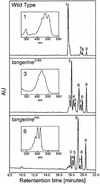Cloning of tangerine from tomato reveals a carotenoid isomerase essential for the production of beta-carotene and xanthophylls in plants
- PMID: 11884678
- PMCID: PMC152916
- DOI: 10.1105/tpc.010303
Cloning of tangerine from tomato reveals a carotenoid isomerase essential for the production of beta-carotene and xanthophylls in plants
Abstract
Carotenoid biosynthesis in plants has been described at the molecular level for most of the biochemical steps in the pathway. However, the cis-trans isomerization of carotenoids, which is known to occur in vivo, has remained a mystery since its discovery five decades ago. To elucidate the molecular mechanism of carotenoid isomerization, we have taken a genetic map-based approach to clone the tangerine locus from tomato. Fruit of tangerine are orange and accumulate prolycopene (7Z,9Z,7'Z,9'Z-tetra-cis-lycopene) instead of the all-trans-lycopene, which normally is synthesized in the wild type. Our data indicate that the tangerine gene, designated CRTISO, encodes an authentic carotenoid isomerase that is required during carotenoid desaturation. CRTISO is a redox-type enzyme structurally related to the bacterial-type phytoene desaturase CRTI. Two alleles of tangerine have been investigated. In tangerine(mic), loss of function is attributable to a deletion mutation in CRTISO, and in tangerine(3183), expression of this gene is impaired. CRTISO from tomato is expressed in all green tissues but is upregulated during fruit ripening and in flowers. The function of carotene isomerase in plants presumably is to enable carotenoid biosynthesis to occur in the dark and in nonphotosynthetic tissues.
Figures







Comment in
-
Tangerine dreams: cloning of carotenoid isomerase from Arabidopsis and tomato.Plant Cell. 2002 Feb;14(2):289-92. doi: 10.1105/tpc.140210. Plant Cell. 2002. PMID: 11884674 Free PMC article. No abstract available.
References
-
- Bartley, G.E., Scolnik, P.A., and Beyer, P. (1999). Two Arabidopsis thaliana carotene desaturases, phytoene desaturase and ζ-carotene desaturase, expressed in Escherichia coli, catalyze a poly-cis pathway to yield pro-lycopene. Eur. J. Biochem. 259, 396–403. - PubMed
-
- Beyer, P., Croncke, U., and Nievelstein, V. (1991). On the mechanism of lycopene isomerase cyclase reaction in Narcissus pseudonarcissus L. chromoplasts. J. Biol. Chem. 266, 17072–17078. - PubMed
-
- Beyer, P., Nievelstein, V., Albabili, S., Bonk, M., and Kleinig, H. (1994). Biochemical aspects of carotene desaturation and cyclization in chromoplast membranes from Narcissus pseudonarcissus. Pure Appl. Chem. 66, 1047–1056.
-
- Breitenbach, J., Kuntz, M., Takaichi, S., and Sandmann, G. (1999). Catalytic properties of an expressed and purified higher plant type ζ-carotene desaturase from Capsicum annuum. Eur. J. Biochem. 265, 376–383. - PubMed
-
- Britton, G. (1988). Biosynthesis of carotenoids. In Plant Pigments, T.W. Goodwin, ed (London and New York: Academic Press), pp. 133–180.
Publication types
MeSH terms
Substances
Associated data
- Actions
LinkOut - more resources
Full Text Sources
Other Literature Sources
Molecular Biology Databases

